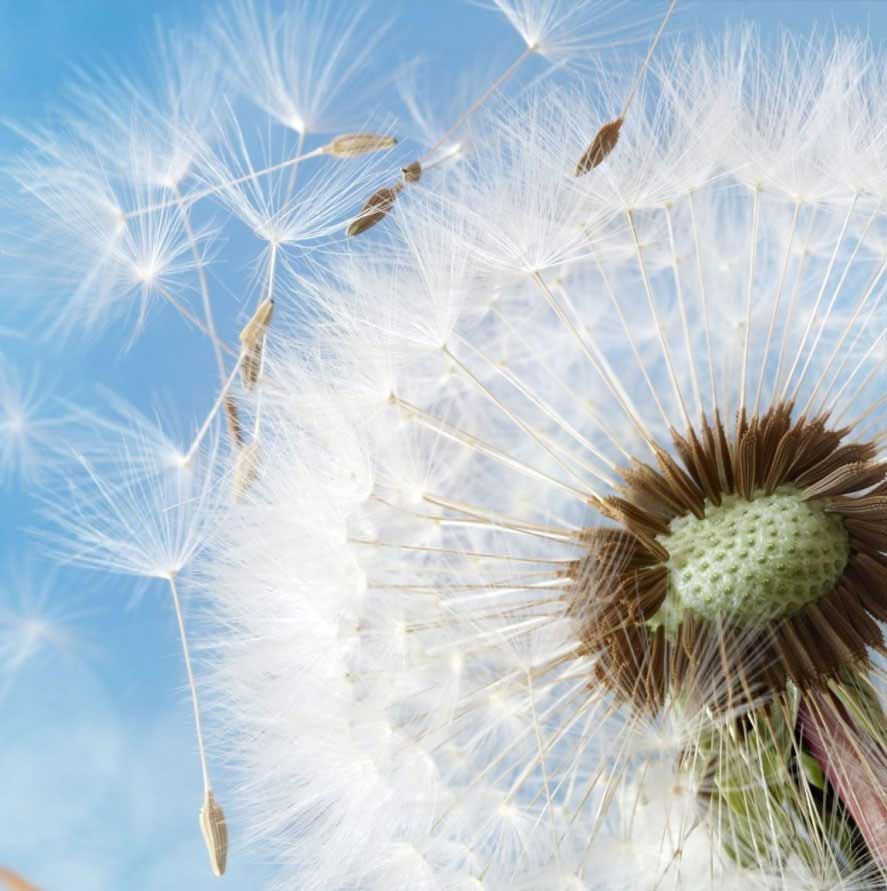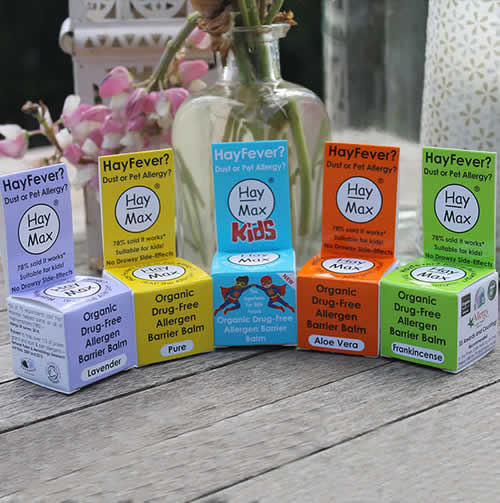Drug-Free & Natural Help
Drug-Free & Natural Help for hay fever, dust & pet allergies
Scroll down for herbal help (including aromatherapy).
There are many drug free ways for adults and kids to tackle allergy symptoms; these are just a few. Natural allergy remedies are often unproven without many clinical trials to prove their efficacy. You have to make your own judgement about whether these treatments for hay fever are worth trying.
Allergen Barrier Balms
HayMax allergen barrier balm is used to stop allergens from entering the body through the nose. It’s suitable for children and pregnant and breastfeeding women.
HayMax has been proven to trap dust allergens, pet allergens and over a third of pollen before it enters the body.
Find out more about HayMax Allergen Barrier Balms here.
Bee Prepared Daily Defence Immune Support
Bee Prepared Immune Support is the ideal immune boosting wellness formula for you and your family and contains only all natural ingredients which have a history of benefits and clinically researched actions which help support the immune system.
Air Filters and Air Purifiers
There are a number of air filters and air purifiers on the market which claim to filter toxins, including pollen, out of the air in your home. Some air conditioners come with a ‘hay fever filter’.
Sneeze Beam
The sneeze beam uses phototherapy to combat allergy symptoms.
Two light beams are inserted into the nostrils and they block the receptors which react to pollen.
Acupuncture and Acupressure
Practitioners use both acupuncture and acupressure to treat hay fever.
Acupuncture originated in China more than 2,000 years ago. It is a system of complementary medicine in which fine needles are inserted in the skin at very specific points of the body (acupuncture points) along channels known as meridians. It is used in the treatment of various physical and mental conditions, including allergies such as hay fever.
Acupressure is a non-invasive form of acupuncture, achieved by applying physical pressure of hands, elbows, feet or devices to the same acupuncture points. It too is used in a wide variety of conditions including hay fever.
Q-Chi Acupressure Band
Based on acupressure, the Qu-Chi band is a non-invasive, natural way to treat allergy symptoms. It uses acupressure to target key pressure points on the body associated with allergy symptoms. A band is worn on any of these pressure points, including on the elbow.
Nasal Filters
The nasal filter is a disposable filter that you stick under your nostrils to block pollen and other allergens from entering your body by stopping you inhaling them. Breathe Pure is one popular make.
In 2004 an Australian study found that nasal filters were 98% effective at trapping pollen and 68% effective at reducing hay fever in symptoms in highly allergic people. The study was done in a lab and in a field of rag weed.
More information
herbal help & aromatherapy
Herbal medicine has been around for a long time. People have been using herbs & plants to cure illness since the Palaeolithic era, according to archaeological evidence. That’s around 60,000 years ago. Today, plenty of modern medicines – the World Health Organization (WHO) says a quarter of drugs now in use in America – are derived from plants. WHO also estimates that 80 percent of the population of some Asian and African countries currently use herbal medicine for some aspect of primary health care.
There are many options for you to pursue if you want to explore using herbal help for hay fever. Before you do, though, you should bear these things in mind:
- “Natural” doesn’t necessarily mean “safe” – or even “harmless”. The NHS website warns that herbal medicines “should be used with the same care & respect as pharmaceutical medicines”
- BUPA’s website says “Herbal remedies contain active ingredients and may interact with other medicines or cause side-effects. Don’t start taking any herbal remedies without speaking to your GP or pharmacist first. It’s also important not to stop taking any prescribed medicine without speaking to your GP, and not to exceed the recommended dose of herbal medicines.”
- Clinical trials of herbal medicines are extremely rare. This means that evidence of the effectiveness of using herbal help for hay fever is also extremely rare
- Check that any product you buy has either the Traditional Herbal Registration (THR) logo or a product licence number displayed on it
- Apply common sense, and check with your GP or pharmacist before taking herbal remedies
- Absence of evidence is not evidence of absence. Just because there is no evidence that herbal remedies work for hay fever doesn’t mean they don’t work. It just means no-one can prove they do – or don’t
OK, so much for the health warnings. What about the herbs?
Plants & Herbs that may help with hay fever
There are many plants, herbs and components of plants and herbs that may help with hay fever or pet or dust allergy. Here are some of those most commonly suggested:
Aloe Vera has mild antihistamine properties. It also promotes digestion and helps to clear skin problems. You can drink the juice diluted in water. Used externally as a gel it cools and soothes allergic skin rashes and itchy skin.
Butterbur is a herbal extract believed to have an antihistamine-like effect on hay fever symptoms. A 2005 medical study found that butterbur was as effective as antihistamines in treating hay fever symptoms. However, people allergic to ragweed or chrysanthemum should avoid butterbur and it should be consumed carefully as it can cause indigestion, fatigue, vomiting or constipation. Butterbur extract is available in capsules from a wide range of online sources.
Calendula and Chamomile tea are both reputed to relieve hay fever symptoms. Some herbalists suggest smearing chamomile and lemon oil on a tissue and inhaling.
Ginger, Peppermint and Green tea are all said to reduce hay fever symptoms. Ginger and green tea work as natural anti-histamines whilst peppermint reduces congestion.
Ginkgo biloba is thought to decrease the body’s response to allergens while also increasing energy levels and circulation. It is available in most health food shops and is usually taken in capsules.
Honey is not a herb or a plant but so many people find it beneficial we felt it had earned its place in the list. Eating locally-produced honey regularly throughout the year may help in building up the body’s immunity, thereby reducing your over-reaction to pollen when it’s released. For this to work, the honey must be very local to you. One argument against this is that local honey may not be helpful when you leave your local area.
Horseradish is a pungent root vegetable which acts as a decongestant, helping to clear nasal passages. Grated fresh horseradish root adds a great kick to roast meats and vegetables.
Liquorice root can ease inflammation and redness in the nose and is also believed to have anti-viral and anti-bacterial properties that can help boost the body’s immune response to hay fever, dust and pet allergies. It can be drunk as a herbal tea.
Reishi Mushrooms are thought to be rich in beta-glucans which positively effect the immune system and reduce inflammation. They also supposedly have anti-histamanic properties. Reishi mushrooms contain significant levels of vitamin D2. Boosted vitamin D levels have been linked to helping reduce allergy development.
Nettle is available in capsule form from health food retailers, some supermarkets and online. The recommended dose is two 300mg capsules daily, to be taken when you experience symptoms. It can also be drunk as an infusion or made into soup. To make nettle soup, pick only the tender young leaves at the tip of the plant in early spring, after which the leaves become coarse. Recipes can be found online.
Quercetin is thought to limit the release of histamine. As well as being found naturally in many foods (Wikipedia lists 30, with raw and canned capers at the top) it can also be taken in a capsule. The recommended dose is 250-600mg per day, taken 5-10 minutes before meals. NB Quercetin is not recommended during pregnancy.
Turmeric Commonly used in Middle Eastern and Asian cuisine, turmeric is a spice containing curcumin, which has been found to have anti-allergy properties. Most often used in dried form, it can also be bought fresh. It looks similar to ginger root. Put on your rubber gloves (it stains!), peel a section and grate, then add about two teaspoons to rice dishes, stir-fries or soups. Or anything else you fancy.
AROMATHERAPY
Aromatherapy is a traditional, natural way to treat a variety of ailments including allergy symptoms.
It is important to use a high quality pure, natural essential oil with genuine ingredients, not a synthetic version which won’t bring the same benefits, and always follow instructions.
Useful Oils to Treat Allergies
- Roman chamomile or camomile is soothing and can lessen your reaction to pollen.
- Lavender is renowned for its healing, calming and soothing properties.
- Geranium is balancing. (Geranium may not be suitable for pregnant or breastfeeding women as it affects the hormones).
- Pine is strengthening and can help clear nasal congestion.
- Rosemary is uplifting and can help clear nasal congestion.
- Juniper is detoxifying.
- Eucalyptus is clearing.
- Niaouli and Tea Tree oil also have helpful properties for hay fever.
- Carrier oils include sunflower, coconut and olive.
Aromatherapy Top Tips to Relieve Allergies
- Spray a homemade lavender or eucalyptus room spray throughout the house and especially in the bedroom before you go to sleep.
- Try some on your pillow to help you sleep and to clear your sinuses while you sleep.
- A blend of chamomile, lavender and lemon added to your bath or diffused in a burner may help relieve symptoms, particularly at night before you go to sleep.
- It is important to note that you should not put pure, undiluted essential oils (except for Lavender) directly onto the skin. Always research how to use essential oils before use.




